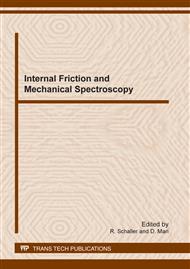p.24
p.33
p.42
p.52
p.63
p.69
p.75
p.81
p.87
Ab Initio Based O-O Investigation and the Snoek Relaxation in Nb-O
Abstract:
t is common knowledge that interstitial-interstitial interaction influence on the Snoek relaxation. We used a computer simulation of this effect in the Nb-O alloy to test the adequacy of various models of the O-O interaction and clarify the mechanism of this effect The energy calculations in the first twelve coordination shells have been performed by the projector augmented-wave (PAW) method as implemented in the Vienna ab initio simulation package (VASP). The energies have been calculated in different ways which vary in the method of determination the energy of non-interacting O-O pairs. The energies calculated on the various variants are similar but in one case there is O-O repulsion in all first twelve coordination shells, whereas in another one can see attraction in four of twelve shells. Internal friction Q-1 was calculated as a sum of the contributions from individual interstitial atoms in different environments, each of which being assumed to be the Debye function. It is assumed that long-range interaction of oxygen atoms affects the distribution of these atoms and the energy of each interstitial atom in the octahedral interstices before a jump and after a jump. The Monte Carlo method is used for simulating short-range order of interstitial atoms and for calculating values of energy changes. Comparison of the calculated temperature and concentration dependence of the Snoek peak with the published data showed that the PAW supercell calculation of the O-O interactions in Nb describes the behavior of the interstitial solid solution adequately. It proves also that the impact of interstitial atom concentration on the Snoek relaxation is connected to the mutual attraction of these atoms.
Info:
Periodical:
Pages:
63-68
Citation:
Online since:
January 2012
Authors:
Price:
Сopyright:
© 2012 Trans Tech Publications Ltd. All Rights Reserved
Share:
Citation:


